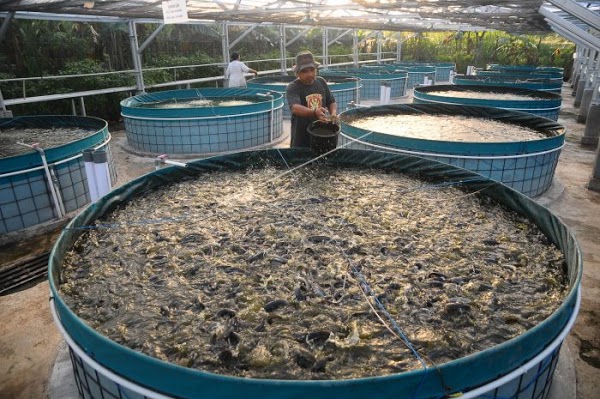UNAIR NEWS – One alternative that is considered to be a solution for fish farming with limited land and water in the future is the biofloc system. It does not need large areas of land and intense water changes for fish farming with high stocking density. On Monday, November 16, Universitas Airlangga Off Main Campus Program Aquaculture Program in Banyuwangi held a guest lecture to discuss cultivation techniques using the biofloc system.
Ir. Suprapto, mentor of 165th Farmbiofloc Catfish Farming Group, was the speaker for the occasion. He revealed that the biofloc system is able to maintain the parameters of the cultivation medium with high stocking density without changing water because it can convert the waste in the media into a food source for the fish.
“In the biofloc system, the organic waste in the media will be recycled by the bacterial ecosystem into microbial cell proteins which will form clots (floc) which can be eaten by fish,” said the Shrimp Club Indonesia (SCI) technical team member.
To form a biofloc ecosystem, some requirements must be met, including the composition of the bacteria present in the media. To form flocs, bacteria are needed to produce compounds to bind bacterial cells that use organic waste to grow so fish can eat them.
“In general, we use a combination of Lactobacillus, Bacillus subtilis and Bacillus licheniformis bacteria in probiotics included in the media, because besides being able to play a role in decomposing organic matter, Bacillus licheniformis also functions to produce biopolymers that bind bacterial cells to be eaten by fish,” he explained.
In addition to the composition of bacteria, he continued, there are other requirements such as DO and sufficient stirring and a C / N ratio value> 10. So the biofloc system must have aeration and control by giving molasses in feed as a source of C to maintain C / N ratio in the media.
The stages in the preparation of biofloc system media, according to Suprapto’s presentation, include sterilization of media water using chlorine, increasing salinity to 3 ppm with salt and floc formulation on the 5th day with probiotics and molasses.
“To accelerate the formation of flocs, rice bran which has been fermented can be given and after the floc is formed or around the 10th day, the seeds can be stocked,” he explained.
Ending the presentation, Suprapto revealed that the biofloc system is only good for fishes whose protein requirements are below 40%. If it needs high protein, farmers have to add a lot of C from the molasses to maintain the C / N ratio causing the floc to be too dense and affecting the fish.
“The need for flocs in each fish is different. If it is too dense, it can affect the respiration and growth of the fish, so fish which needs protein above 40% is rather difficult to cultivate with biofloc,” he concluded.
Author: Ivan Syahrial Abidin
Editor: Nuri Hermawan





